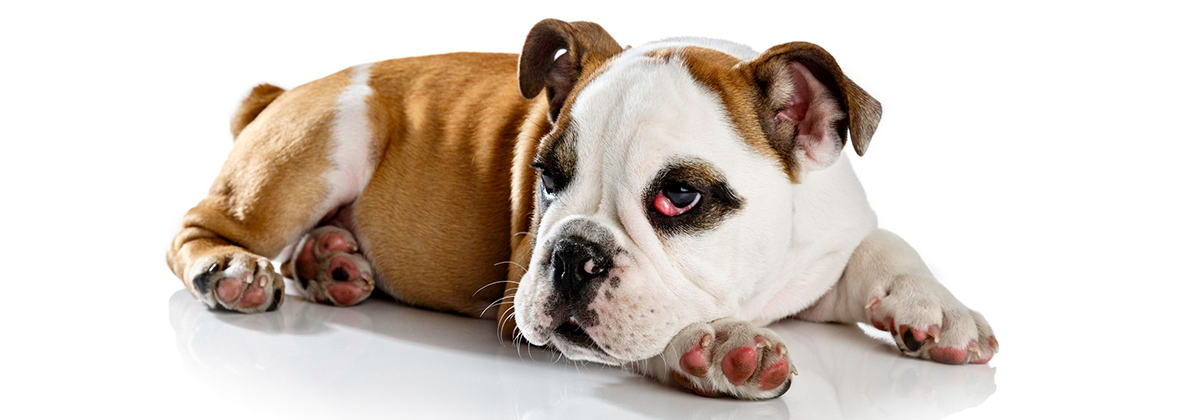20 Jan Cherry Eyes in Dogs: Causes, Symptoms, & Treatment (Part 1)
Protrusion of the dog’s third eyelid gland, prolapsed lacrimal gland of the third eyelid or the same cherry eye disease in dogs can occur in only one or both eyes. Of course, less than half of the dogs have this problem in both eyes. This dog disease may be temporary, meaning it will heal soon and may recur after a while, or it may be permanent and not heal on itself. Any dog can get cherry eyes, but some breeds are more susceptible to the disease. In the continuation of this article, you will learn everything you need about this disease.
Cherry eyes definition
Many animals, including dogs, have a nictitating membrane in their eyes or the third eyelid (NM) inside the lower eyelid. This third eyelid acts as an extra protective layer for the eye (especially when hunting or fighting other animals) and has a special gland that secretes a large portion of the eye’s tears. A few ligaments hold the tear gland firmly in place under the eyelid, but sometimes the ligaments can’t do their job properly for any reason and the lacrimal gland prolapses and protrude.
The lacrimal gland of the third eyelid is attached to the lower inner edge of the eye with special ligaments. One end of the ligament is attached to the eye socket bone and the other end holds the gland in place. Sometimes the ligament stretches and loosens, or separates from the bone. When this situation happens, the tear gland comes out and is placed above the eyelid, so that it is fully visible. In this case, it seems that there’s a small cherry in the corner of the animal’s eye, and that’s why we called this problem the cherry eye.
Symptoms cherry eye In dogs
- A smooth, soft, round bump or mass of red or pink in the corner of the eye, on the lower eyelid inward (dog snout side).
- Concentrated discharge from the eyes
- The dog may not close his eyes
- He tries to rub his eyes with his paws
Usually, the first sign is very easy to recognize. Cherry eyes in dogs may be large and cover a large part of the cornea, or they may be small and appear only occasionally. This disease doesn’t bleed and isn’t painful. Other problems (dry eyes, corneal ulcers, inflammation of the cornea) can cause the dog to rub his eyes, along with protrusion of the lacrimal gland.
The third eyelid is responsible for causing tears, and cherry eyes cause dryness and inflammation due to the lack of tears. There may even be sores in the eye (especially if the animal touches his paws or rubs his eyes on the ground). If the cherry eye is large enough, it can make it difficult or even impossible for the dog to close the eye completely. Keeping the eye open will make it even drier.
Of course, some other problems can cause the same symptoms. Some of them, such as being hit or entering a foreign item in the eye, are also acute problems that can cause vision loss or even depletion and loss of eyes. So if you see anything unusual in your dog’s eye, it’s better to visit your veterinarian. Always try to diagnose and treat the disease as soon as possible to get better results.
Cause of cherry eyes in dogs
It isn’t yet known exactly why ligaments fail and cause cherry eyes, but we know that certain breeds are more susceptible to the disease than others. In these breeds, it seems that the ligament connection is weak and as a result, the gland falls much more easily.
Cherry eye susceptible breeds
In general, in brachycephalic Breeds (dogs that have a compact face, shorter snout, and short arms and legs), as well as very small and miniature breeds, cherry eyes are more likely than dogs with long, normal, and large snouts. It can occur at any age but is most common in dogs 2 years old or younger, and especially puppies under one-year-old. The breeds that seem to be genetically predisposed to this disease are:
- Basset Hound
- Boxer
- Bloodhound
- Boston Terrier
- Bullmastiff
- English Bulldog
- French Bulldog
- Beagle
- Pug
- Pekingese or Pekingese
- Terrier
- Rottweiler
- St. Bernard
- Shar-Pei
- Shih Tzu
- American Cocker Spaniel
- Cane Corso
- Great Dane
- Lhasa Apso
- Neapolitan Mastiff
- Maltese
- Newfoundland




Sorry, the comment form is closed at this time.